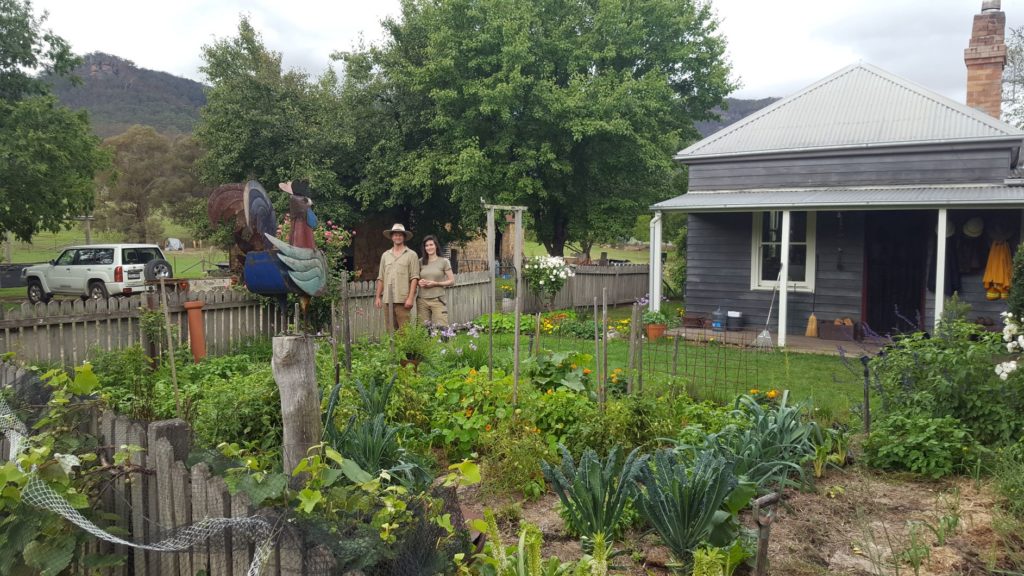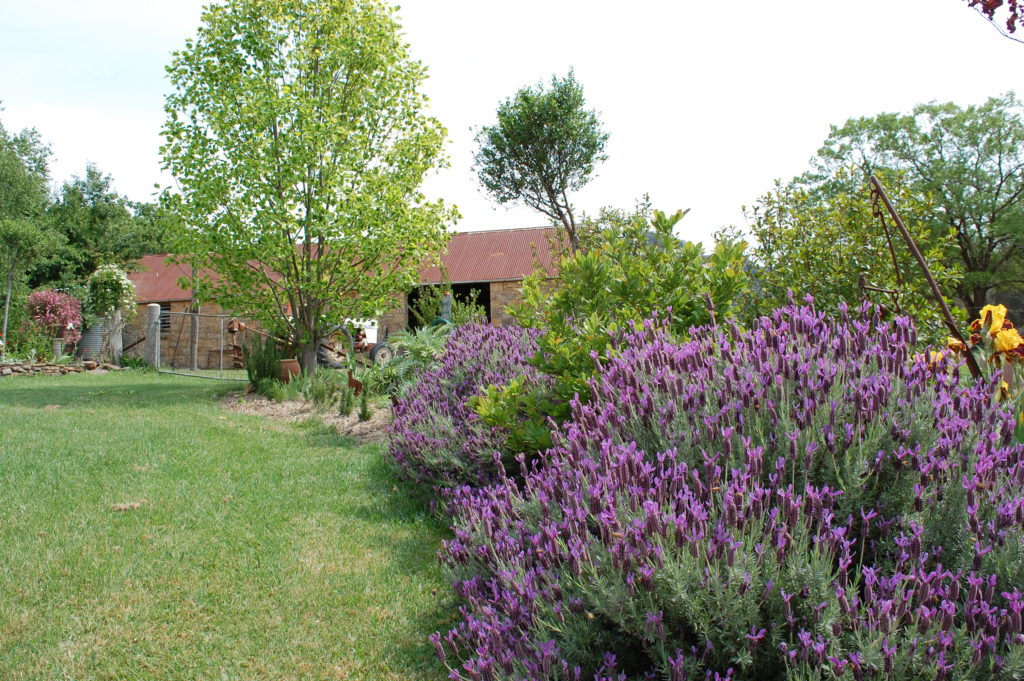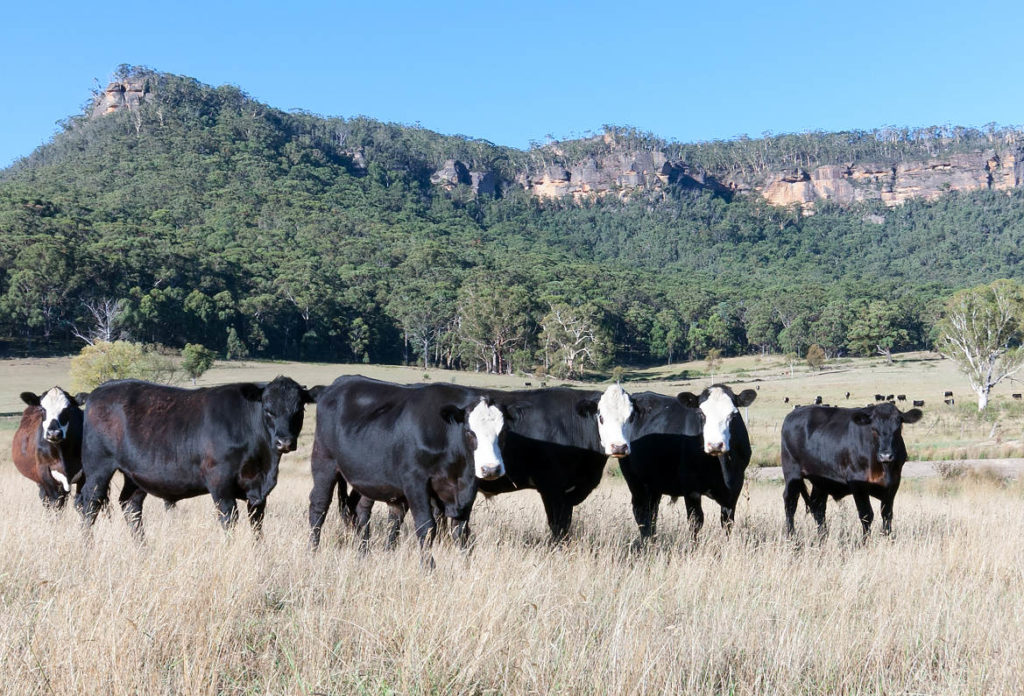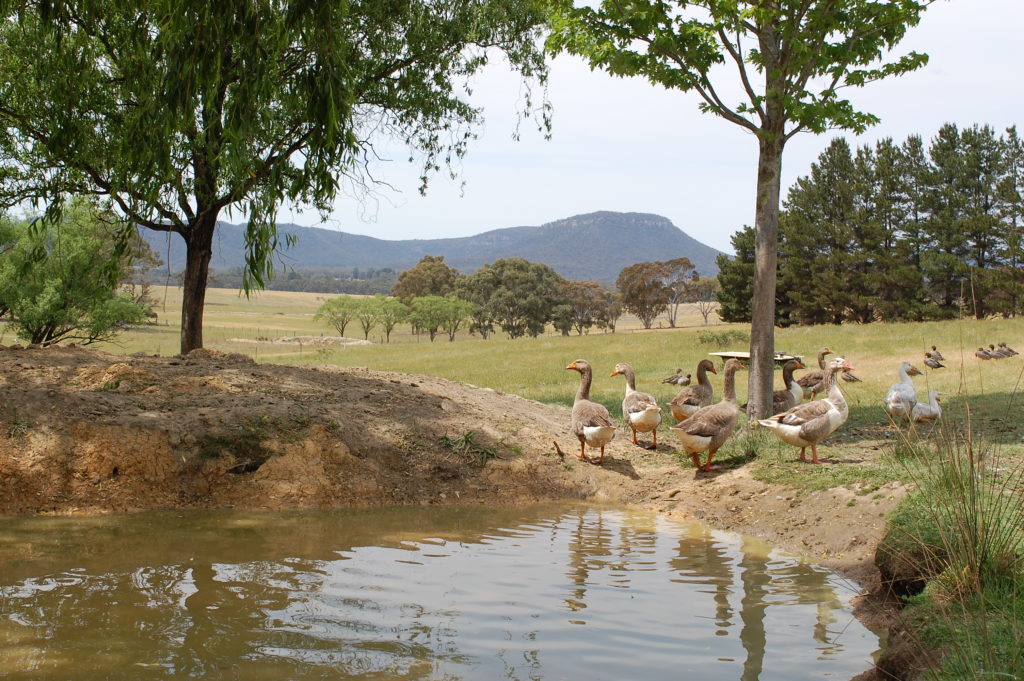Meet the producer
Nic & Josee Moodie – Beef and veg growers, Hartley

Following results of a member survey, to which the majority of responses indicated support for the sale of meat at the Co-op, the board agreed to source suitable local produce that would be available to purchase via an ordering system.
After careful deliberation, development of a Fresh Meat Purchasing Policy with the strictest of criteria in regard to land regeneration and animal welfare, and on site farm inspections conducted by our manager and a member of the board, we have located a local farmer who ticks all our boxes.
Our supplier is Nic Moodie, whose family have owned Southleigh Farm in Hartley for the past 33 years. Over this time, they have lovingly restored what was a depleted old sheep station into a diverse and thriving permaculture-inspired farm, planting hundreds of trees and providing sanctuary for local wombats along the way. Sonya Byron caught up with Nic down on the farm.
Sonya: How has your property evolved over the years.
Nic: Southleigh has been our family farm for 33 years. The property is approximately 200 cleared hectares backing onto a couple hundred more of bush. It’s a beautiful spot immediately under the stunning sandstone escarpment of Mt Clarence that catches the red light of the setting sun. It’s full of gardens and flowers and birds, but it’s come along way over the last thirty years. When we bought the farm it was in a pretty ramshackle state. The house was derelict, fences were rundown and the old sheep sheds were totally dilapidated. It did however have a beautiful turn of the century stone barn that still takes pride of place.
The first couple of years were spent looking after the land that was in a pretty poor state. As much as I tried to be helpful, as a 7-year old I think I probably spent as much time yabbying and chasing rabbits with my dog as I did helping, but we slowly got things done. We built a yard for cattle, repaired the old well, fixed up the fences and got the house back in shape. The former owner, Charlie, had a great vegie garden. It hadn’t been looked after for a few years but with a bit of love that vegie garden has been going strong ever since.

Sonya: Tell us a little bit about your background in gardening/farming/and your other environmental work.
Nic: One of my earliest memories is planting radish with my dad and the joy of watching those tiny little specks turn into something as wondrous as a plant. Being a very outdoorsy family our childhood holidays were spent disappearing into the bush or desert to fish and explore, so I’ve always loved the natural world. I’ve had gardens in share-houses, in abandoned buildings, lane-ways and along train lines. I’m a big believer in community agriculture and think there’s no better way to engage with the world than by growing things. As much wiser minds have said, “all the world’s problems can be solved in a garden”. I came in contact with permaculture as a design system in the mid 2000’s and have been trying to apply many of its principles to my professional work and life ever since.
I’ve spent several years working for environmental advocacy groups and in the private sector on events like the Peats Ridge Festival where we achieved some work I’m really proud of. I’ve worked for local and state government, and still work as an environmental/carbon consultant when the farm permits. I’d definitely rather be on the farm though. We’re in the early days of offering environmental workshops for schools too as I think building the next generation’s connection to the environment is perhaps the most important work we can do.

Sonya: What is your approach to regenerative farming?
Nic: For me, I guess first of all it comes down to respect. Respect for the land we’re lucky enough to be caretakers of and for the animals and plants that live here. Too much of our precious environmental capital has been destroyed in my lifetime and to work to find ways to live in better balance with this land has to be key. So we’ve been working to repair systems that have been damaged – restoring good hydrology to the creeks, eliminating erosion and allowing regeneration of important bushland. We have a population of Copper Wing Butterfly on the farm that live symbiotically with the blackthorn and a local ant species.
We’ve planted hundreds of local (and some introduced) trees which have changed the place hugely for the birds and will provide hollows for habitat soon. Mange is a real problem for the wombat population and we manage that with advice from the local vet. I think you could probably call our place a wombat sanctuary based on the number of fat wobblers you see scooting around the paddocks at night.
Sonya: How do cattle fit into your regenerative system?
Nic: I guess one of the first questions people ask is “why beef?” While pastured beef doesn’t have the carbon intensity of feed-lotted animals or those raised on recently cleared land – it is intensive as a ruminant. From a biodiversity perspective though it has a far smaller impact. I know first-hand how many native and feral animals are shot or trapped or poisoned to protect both smaller stock and fruit crops. My neighbour lost three quarters of his lambs this year and is constantly at war with dingoes, wild dogs and foxes, and inadvertently the quolls that we so rarely see.
Maintaining a small cattle herd (which fluctuates depending on the season, currently we have 38 cows) allows us to have massive biodiversity compared to smaller potentially less carbon intensive animals. Cows have large feet so are less compacting of soils, and they have softer mouths and graze fewer species meaning the potential for native regeneration is better. So from our perspective beef is the best stock assuming we manage our soils and forestry for carbon accumulation. We have lots to learn still but we’re certainly hungry for the knowledge and love the place deeply. We’re at the start of a generations- long journey.

Sonya: What is your approach to pasture management?
Nic: These days we work with perennial pastures, which are mostly naturalised and native but diverse, with a goal of accumulating soil carbon. We only use compost as fertiliser and no chemical fertilisers or sprays. I was very impressed with the work of Colin Seis when I studied agriculture at school and while we don’t do much tillage, we’re getting into pasture cropping to improve yields in our summer pastures using oat based mixes over winter. The goal is maintaining good grass cover as the top priority.
Sonya: Tell us about the species of grasses in your pastures, how you sow them and how the pasture has changed over the years?
Nic: After an initial hundred years of set stocking all the best grasses were being eaten out. Now we’re moving back to allowing perennials that still have good seed stock in the soil including kangaroo grass and poa along the creek systems. It’s likely we will keep seeing the natural recharge from soil seed storage but I’m also interested in sourcing more resilient local varietal seed to advance the process – particularly in areas where a history of cropping has eliminated much of the soil seed bank.
We’ve been top dressing with compost – both industrial compost from green waste and making large quantities onsite from local waste streams of wood chips and cafe scraps, horse manure and bedding from other farms. Our compost is certainly better quality than the industrial compost. Seeding has mostly been done in combination with compost spreading and minimum tillage equipment.
We’re mostly seeding deep-rooted perennials like chicory to assist with soil decompaction and because it’s quality feed. Also annuals like turnip and daikon for decompaction, some hard seeded legumes, some brassica to take advantage of soil moisture and for herd health, and during the drought chia as a milk stimulant for the cows and because it’s so drought hardy and bio-accumulative. I think diversity is good. No season is identical and nothing is right under all conditions.

Sonya: What does your stock rotation look like? How long do you rest paddocks?
Nic: We live in a very changing environment season to season so there’s no single standard. It depends on moisture, paddock species, season, number of animals. I think most importantly it’s driven by pasture condition and to a degree stock, desired outcome and feed availability. The goals in order are probably – maintain groundcover, maintain/improve stock condition, maximise pasture regeneration. We have larger general grazing paddocks 5-7 hectares but also smaller areas that can be isolated for pasture cropping, for storage and composting.
Sonya: Like everyone, you have been affected by the drought – what measures have you taken to manage the recent dry in regards to reducing stock numbers, feeding etc.?
Nic: It’s been the two worst seasons we can remember at the farm, and as bad as living memory in the valley. Our permanent creeks basically dried up. It’s been a really hard season financially for the farm and the paddocks have looked terrible by our standards. We’ve got a smaller herd than we’ve had since our first few years and we would only normally need to feed during winter. Instead we’ve been almost totally hand feeding since November. Bushfire knocked out a lot of fencing and rangeland grazing country across the back of the farm so there’s plenty to do. But the farm’s resilient and will bounce back. Fortunately, we didn’t lose any animals or buildings like some of our neighbours.
Sonya: And now with all the rain, how are you faring?
Nic: It’s been a full Dorothea Mackellar turnaround! We had nearly 1/4 of our annual rainfall over a few days. Fortunately, we have reasonable ground cover still so the whole lot didn’t wash away. With rain back in the dam the pressure is definitely off a bit. Hopefully we won’t lose as many trees as it was looking like a month ago. So there’s new (more drought tolerant) trees to plant in some places, and pasture to be drilled with oats to take advantage of the good soil moisture.
While we’ve got good soil moisture we’re still several hundred millimetres down on the long term average over the last couple of years. So I wouldn’t say we were out of drought just yet. We’ll need a more general shifting of the long term rainfall pattern but it’s lovely to see the creeks flowing again.
Sonya: What are your hopes and plans for the future on the property?
Nic: With Josee and I both being involved with the fire effort over November and December first up we’re going to go bush for a week and sleep a lot. But in the longer term we’re keen to keep building up food production, we already grow more vegies and fruit in polyculture and vegetable gardens than we need and the surplus goes to local cafes and the Co-op.
I’ve always been enamoured with the work of Yeoman on keyline landscape water systems. It’s a large change in the way we’d work the place on a piece of land this size but it was developed as much as a fire management system as a water harvesting system so our experiences over the last couple of fires in the valley might lead us down that road. There’s no doubt we are in a drying climate and storing water in the landscape has never been more important.
Ordering
Don’t miss out! Order your fresh local meat pack today.
To support our local farmers, and nose-to-tail eating, the Co-op has partnered with Lyttleton Stores to purchase whole cows from Southleigh Farm in Hartley.
Pre-paid 5kg packs of beautiful pasture-raised, free-range beef are available to order at the Co-op in Katoomba until Sunday 22nd March for delivery April 9th.
The pack will (on average) contain 1-2kg high quality cuts (eg: steak), 1/2-1kg roasting meat, 2kg sausage/mince. The cost is $175 members and $194.44 non-members. Packs must be ordered and pre-paid in the main shop.
If you’re after individual cuts you can purchase them from Lyttleton Stores at Lawson. Lyttletons also use the bones and offal from the animal for broth and to sell in their shop.
Enquiries: Blue Mountains Food Co-op 4782 5890
Lyttleton Stores 4759 3478


